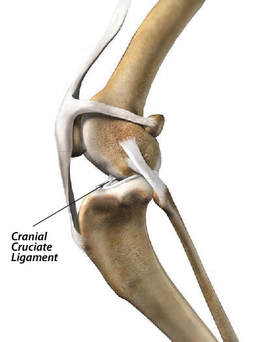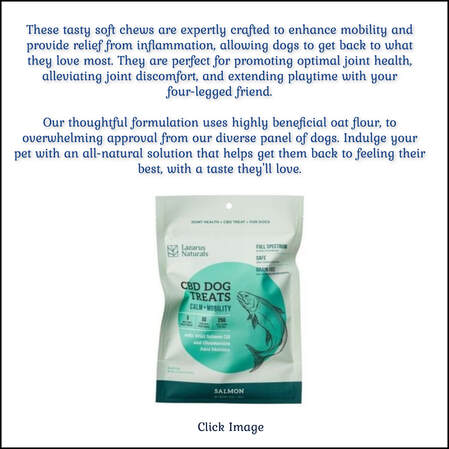
BY NARDA ROBINSON, DO, DVM
Imagine you twisted your knee and your doctor diagnosed an injured anterior cruciate ligament. What if she offered you only surgery or euthanasia (hypothetically legalized for humans)? Would you explore alternatives or accept this false dilemma? Would it change your mind if you discovered that more enlightened surgeons are exhorting their colleagues to stop cutting cruciates at least until patients have undergone a month or more of conservative care? In the same vein, why do some veterinary surgeons limit options for dogs, forcing clients to choose between breaking their hearts and breaking their banks? Yes, canine and human stifles differ, but the chronicity and persistence of canine cruciate disease argues in favor of a long-term, rehabilitative and integrative approach, not for bone saws. Moreover, far from being a slam-dunk diagnosis and treatment, confusion lingers. Unknowns persist about whether a lameness is indeed due to cruciate injury and if so, what caused it. Furthermore, “The ideal treatment modality for cranial cruciate ligament (CrCL) injury has yet to be determined...” |
|
Consumers want options. Many in our profession insist that only surgery or euthanasia allows dogs to avoid a life of disabling pain, arthritis and poor quality of life.
What does the evidence say about their claims? Claim No. 1 “A chance to cut is a chance to cure.” False. Cutting does not cure cruciate disease. In fact, about half of Labradors rupture the contralateral CCL within six months after tibial plateau leveling osteotomy. Evidence indicates that TPLO does not halt the progression of osteoarthritis in dogs. TPLO outcomes vary widely and long-term clinical trials are lacking. In fact, three studies show that radiographic signs of OA significantly worsen after TPLO. This concurs with human evidence indicating higher OA morbidity following surgery as opposed to conservative care. |
|
Claim No. 2
“Studies with force plates demonstrate the superiority of the TPLO.” False again. “There is little good scientific evidence that any one surgical procedure is better than any other,”even though many surgeons advertise or teach that TPLO is the “gold standard.” Also, force plate analyses paint an incomplete picture, especially for dogs with naturally occurring disease and multi-limb lameness. Kinematic parameters differ between breeds, arguing for the establishment of normative data in healthy dog populations before making inferences about injured clinic patients. Claim No. 3 “Pelvic limb lameness is cruciate injury until proven otherwise.” Untrue. Who hasn’t stumbled off a curb or strained a muscle after a run? Dogs’ paws, too, may slip and injure soft tissue. However, most injuries do not require surgery for their successful resolution. Rest and wrap, massage, acupuncture, laser therapy and proprioceptive retraining may produce a full recovery for many problems whereas cruciate surgery never restores the limb to normal function. Who pays for the diagnostic error when the surgeon finds an intact ligament? The dog and the client. |
|
Claim No. 4
“The canine stifle differs from the human stifle; therefore, comparisons cannot be made.” This statement merely reinforces the case for conservative care. The chronic, unrelenting course of cruciate disease in dogs emphasizes the need to try a multifaceted non-operative strategy first. Even in humans who usually acutely rupture their cruciate, many advocate rehabilitation: “At present, there are no evidence-based arguments to recommend a systematic surgical reconstruction to any patient who tore his ACL.” Claim No. 5 “Don’t look for things that you don’t want to find (a surgeon’s aphorism).” It is difficult to ignore the long list of complications from TPLO. Up to one-third of dogs experience complications, many require a second surgery to address them, amplifying post-operative pain that much more. TPLO risks include osteosarcoma (with Slocum or non-Slocum plates), soft tissue injuries (lacerated blood vessels, patellar tendon, medial collateral ligament, or long digital extensor tendon); severe intra-operative hemorrhage; tissue reactions to sponge retention; swelling; bruising; infection; and seroma formation. Surgeons may inadvertently fracture the tibia or fibula. Hardware can travel into a joint or break. Additional complications include osteomyelitis, internal tibial torsion, delayed union, ring sequestrum, screw loosening, Kirschner wire loosening, implant failure and draining tracts. |
|
Claim No. 6
“Your dog will be as good as new after TPLO.” No. All surgical approaches for cranial cruciate ligament insufficiency result in some lameness and restricted limb use in the first two weeks. Four to six weeks after that, as the osteotomy heals, muscle mass and thigh circumference typically decrease. While some recovery of TC takes place over time, it likely will not recover fully, and stiffness in that stifle can last five or more years. Alternatively, continued instability of the stifle following TPLO may result in persistent lameness. Claim No. 7 “There is no evidence that acupuncture benefits patients with OA of the stifle (or knee).” Untrue. A systematic review and updated meta-analysis of acupuncture for patients with OA of the knee showed “significantly better relief from knee OA pain and a larger improvement in function than sham acupuncture, standard care treatment, or waiting for further treatment.” Thus, those dogs that do develop OA, with or without TPLO, may benefit from acupuncture, shown to be a safe and effective method to improve physical function, quality of life, range of motion and pain control. |
|
While research on non-surgical approaches to cruciate disease is growing for humans and for dogs, no evidence supports confining dogs in crates for weeks on end. Between dogs who did and did not have stifle surgery, research shows no differences in scores for lameness, stifle instability, OA, and/or force plate outcomes. Conservative management consists of weight loss, omega-3 fatty acids, electrotherapy, cryotherapy, massage, acupuncture, laser therapy, and more, and can be tailored to dogs’ specific diagnosis and athletic performance requirements.
Conclusion The integrative medicine credo “primum non nocere” (“firstly, do no harm”) compels us to consider why, given the facts, clients are forced to choose between surgery or euthanasia and not provided with alternatives. This problem exists in other areas as well, such as the treatment of disk disease, where the case for conservative care rivals or outcompetes that for surgery, for both humans and dogs. Now that 94 percent of Americans feel closer to their dogs than they may to their mothers (87 percent), cat (84 percent) or father (74 percent),42 let us honor this bond by providing clients options and answers, not just surgery or euthanasia. Dr. Robinson, DVM, DO, Dipl. ABMA, FAAMA, oversees complementary veterinary education at Colorado State University. |
Stifle: https://orthodog.com/index.cfm/products/cruciate-care-knee-brace/
Stifle-Expensive: http://www.animalorthocare.com/products/stifle-knee-braces/
Another one on Amazon: https://www.amazon.com/Kruuse-Rehab-Left-Protector-Large/dp/B00Z0U9VFU?th=1
**Canine Arthritis And Joint is intended for informational, educational and entertainment purposes only and is not a substitute for medical advice, diagnosis or treatment. Do not attempt to self-diagnose or treat any health condition. You should always consult with a healthcare professional before starting any diet, exercise or supplementation program, before taking any medication, or if you have or suspect your pet might have a health problem. The opinions expressed by Canine Arthritis And Joint are not to be replaced for medical care. This website and the information contained herein have not been evaluated by the Food and Drug Administration. The information and opinions on Canine Arthritis And Joint are not intended and cannot be used to diagnose, treat, cure, or prevent any disease. This applies to people and pets!
This site uses affiliate links such as banners you may see that allows for paid commissions.
This site uses affiliate links such as banners you may see that allows for paid commissions.
Canine Arthritis And Joint © Copyright 2015-2024
Designed By Paw Prints Web Design
Designed By Paw Prints Web Design











